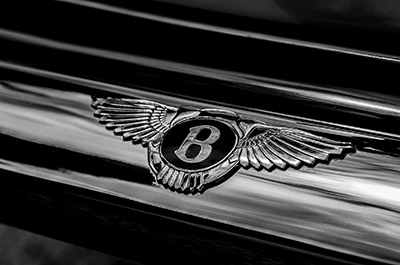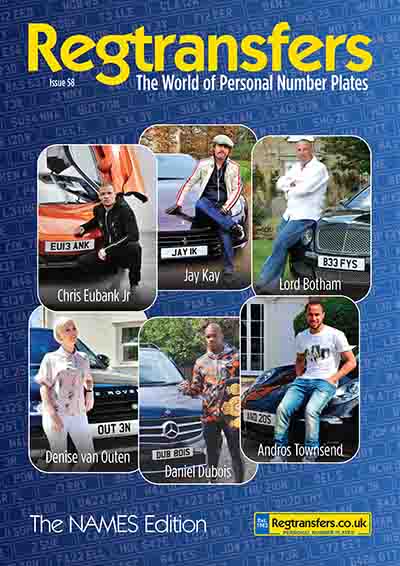
As we mentioned in another article, when the private registration number BMT 216D sold in the September 2022 DVLA auction for £24,553, we struggled to fathom what appeal such a number might have for its buyer. At first sight, it is a fairly unremarkable suffix registration that doesn't seem to spell a name or word. Eventually, we noticed that the BMT 216D is just one character away from BMT 216A. Of course, that fact only becomes meaningful when one realises that BMT 216A was the registration of the iconic Aston Martin DB5 that appeared in the James Bond movies Goldfinger (1964) and Thunderball (1965). Our working theory is that the purchaser of BMT 216D bought the private number plate as a reference to Bond and, possibly, to display on a similar car. Time will tell.
The most famous car in the world?
For some years, the Bond DB5 was known as 'the most famous car in the world' and it still holds a special place in the hearts of many a Bond fan. The new DB5 was the perfect car for the suave secret agent: stylish, fast and British. In the movies, Bond's Aston Martin was fitted with all the custom gimmicks a spy could want: machine guns, battering rams, bullet-proof rear screen, ejector seat and more.
Down the rabbit hole
The DB5 wasn't 007's first set of movie wheels - he had driven a Sunbeam Alpine in Dr No (1962) and a Bentley Mk IV in From Russia with Love (1963) - but it became the car most associated with him.
In several of Ian Flemming's original James Bond stories, the agent drove a 1930, 4.5 litre Bentley Blower. The first time Bond took the wheel of an Aston Martin was in the Goldfinger book that was later adapted for the big screen. Bond's Aston Martin in the book was, in fact, a DB Mk III.

A Bentley Mk IV was another iconic James Bond vehicle.
An iconic prototype
For the 1964 movie of Goldfinger, a more up-to-date model was desired, so someone (reputedly the film's production designer, Ken Adam and its special effects expert, John Stears, persuaded Aston Martin to lend the prototype of their recently introduced DB5 model and to allow Eon Productions to make substantial changes to the car. Those changes included a new 'Silver Birch' paint job and the installation of the secret-agent gadgets seen in the movie. Thus the Aston Martin was transformed into the famous Bond car that was such a big hit with the fans.
Bond drives a used car!
Surprisingly, Bond's acquisition of the pre-production prototype DB5 (chassis no. DP/216/1) wasn't quite the exclusive one might have imagined. That very same car, with its BMT 216A registration plates, had already appeared on television in a 1964 episode of The Saint, an adventure series based on a series of books and stories by Leslie Charteris. The car's appearance in The Saint predates the Silver Birch respray done for the Bond movies, but, as early episodes of the show were shot in black and white, viewers would not have been able to appreciate its original Dubonnet Red colour.
Reminiscent of Bond
The protagonist of The Saint, Simon Templar, is reminiscent of James Bond in many ways. Like Bond, Templar is ostensibly the hero of his tales despite his willingness to do ruthless and questionable things when fighting the baddies. Also like Bond, the Saint is portrayed as dashing, suave and very British. Perhaps the most striking link between the two is the fact that the actor who played Templar in The Saint, one Roger Moore, would later step into the role of James Bond upon Sean Connery's departure from the Eon movie franchise.
One for close-ups
Aston Martin also loaned Eon a second DB5 (chassis no. DB5/1486/R) for Goldfinger, which was used for close-ups and for scenes that required fast driving. This second car eliminated the need to make the gadgets installed in the first car completely invisible until deployed, which would have been very difficult. It also got around handling issues caused by the additional weight from all the special equipment added to DP/216/1.
In addition to the two cars actually used in shooting the film, Eon ordered two more DB5s for use as promotional vehicles. These "press cars" bore the chassis numbers DB5/2008/R and DB5/2017/R and we will be hearing a little more about them a little later.
Take two
The Aston Martins used in the Goldfinger production returned to feature in Thunderball the following year. This marked the last time the original BMT 216A registered car and its "stunt double" would appear in a Bond movie. The DB5 would, however, later appear in six more films in the series but the vehicles used in those were replacements as, by this time, the original cars could not be acquired.
In most cases, the Aston Martins that appeared in these later movies were given different registration numbers from various different countries, but in Goldeneye (1995) and Tomorrow Never Dies (1997) the DB5 displayed BMT 214A and in Skyfall (2012) the car was reunited with its original plate. BMT 216A can be seen as Bond drives to the titular Skyfall house in Scotland.
Post production
After Goldfinger and Thunderball were complete, the original BMT 216A - the prototype vehicle with chassis DP/216/1 which had been modified for effects - had its Bond gadgets removed and was returned to standard specification. It was then sold on to a new owner who promptly reproduced and installed the secret-agent features that had been removed.
The car made one more notable screen appearance in the 1981 movie Cannonball Run. In another amusing twist of coincidence, the car's driver in Cannonball Run was Roger Moore, AKA The Saint and James Bond. Wikipedia states that the DB5 bore the registration number 6633 PP - however, clips and stills from the movie appear to show the Aston Martin displaying P4C 597 E on its plates. Subsequent to this last shot at movie stardom, the original Saint/Bond DB5 was sold at auction in 1986.

No Bond story would be complete without a bit of mystery and villainy and we'd hate to disappoint. In 1997 it was reported that the vehicle had been stolen from Boca Raton Airport in Florida, USA. It is there that the story of DB5 chassis no. DP/216/1 ends for now, as the car has, so far as we can discover, never been recovered, and there remains a reward on offer for its safe return.
One last surprise
Coincidence seems to be a feature of this article and the history of James Bond's Aston Martin DB5, in its various incarnations, is littered with unexpected connections and associations. One, in particular, caught our attention. In 1969, when producers Eon had finished with the two promotional vehicles from Goldfinger and Thunderball, the cars were sold by Eon's Swiss holding company.
Now, stay with us as we take a brief diversion here. It will all make sense.
Our interview guest in issue 55 of our magazine The World of Personal Number Plates was custom watch designer and entrepreneur George Bamford, the man behind the Bamford Watch Department and Bamford London brands. During the interview, George reminisced about the hours of his childhood spent sitting on his father's knee watching James Bond movies. George's father is Sir Anthony Bamford, head of the famous JCB company. Sir Anthony is also the man who purchased the two James Bond DB5 press cars from Eon in 1969. Sir Anthony later sold both cars.
So, there we have it: a brief history of The James Bond Aston Martin DB5 registration BMT 216A. Sources vary a little on the details but we have researched as thoroughly as we can and we think what we have here is pretty accurate.
Of course, after all that, we have to say that if it turns out the purchaser of the BMT 216D registration at the September 2022 DVLA auction doesn't plan to display it on a Bond tribute car, we will be more than a little disappointed.
You might also like
Being Bond with Jack Marsden
Bond themed private number plates

